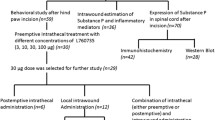Abstract
The ability of 5-HT1A and 5-HT1B agonists to alter a spinal animal's nociceptive threshold was examined using two analgesiometric tests. In the spinal withdrawal reflex test, administration of the selective 5-HT1A agonists ipsapirone, gepirone and PAPP resulted in significant dose-dependent increases in receptive field (RF) area for withdrawal reflexes when compared to predrug baseline values, indicating an increase in nociceptive sensitivity. The average overall percent maximal increase in RF area following administration of 5-HT1A selective compounds was: 80±16% for the ventroflexion reflex, 90±6% for the dorsiflexion reflex and 87±8% for the lateral flexion reflex. Similar to the effects noted with 5-HT1A agonists, administration of 5-HT1B agonists RU24969, mCPP and TFMPP resulted in a hyperalgesic response with an overall percent maximal increase of 43±6% for the ventroflexion reflex, 51±6% for the dorsiflexion reflex and 38±9% for the lateral flexion reflex. In the tail-flick analgesiometric test, administration of the 5-HT1A agonists 8-OH-DPAT and ipsapirone and the 5-HT1B agonists RU24969 and mCPP resulted in a significant dose-dependent increase in tail-flick latencies when compared to predrug baseline values, indicating a decrease in nociceptive sensitivity to noxious thermal stimuli. No differences in magnitude of the effect of the two receptor subtypes were found, indicating that stimulation of either 5-HT1A or 5-HT1B receptors was equipotent in producing the antinociceptive tail-flick response. Administration of the 5-HT1A antagonist meter-goline completely reversed the increase in TFL produced by RU24969, providing further evidence that the effects seen here are mediated by spinal 5-HT receptors. The results of this study indicate that spinal 5-HT1 receptor subtypes may either facilitate or inhibit nociceptive input depending upon the type of nociceptor that is activated, as opposed to the type of receptor subtype that is stimulated.
Similar content being viewed by others
References
Archer T, Arwestrom E, Minor BG, Persson M-L, Post C, Sundstrom E, Jonsson G (1987) (+)8-OH-DPAT and 5-MeODMT induced analgesia is antagonized by noradrenaline depletion. Physiol Behav 39:95–102
Berge O-G (1982) Effects of 5-HT receptor agonists and antagonists on a reflex response to radiant heat in normal and spinally transected rats. Pain 13:256–266
Berge O-G, Fasmer OB, Jorgensen HA, Hole K (1985) Test-dependent antinociceptive effect of spinal serotonin release induced by intrathecal p-chloroamphetamine in mice. Acta Physiol Scand 123:35–41
D'Amour FE, Smith DL (1941) A method for determining loss of pain sensation. J Pharmacol Exp Ther 72:74–79
Dennis SG, Melzack R (1980) Pain modulation by 5-hydroxytryptaminergic agents and morphine as measured by three pain tests. Exp Neurol 69:260–270
Eide PK, Berge O-G, Hunskaar S (1987) Test dependent changes in nociception after administration of the putative serotonin antagonist metitepin in mice. Neuropharmacology 26:1121–1126
Eide PK, Joly NM, Hole K (1990) The role of spinal cord 5-HT1A and 5-HT1B receptors in the modulation of a spinal nociceptive reflex. Brain Res 536:195–200
El-Yassir N, Fleetwood-Walker SM (1990) A 5-HT1-type receptor mediates the antinociceptive effect of nucleus raphe magnus stimulation in the rat. Brain Res 523:92–99
El-Yassir N, Fleetwood-Walker SM, Mitchell R (1988) Heterogeneous effects of serotonin in the dorsal horn of rat: The involvement of 5-HT1 receptor subtypes. Brain Res 456:147–158
Fasmer OB, Berge O-G, Hole K (1984) Metergoline elevates or reduces nociceptive thresholds in mice depending on test method and route of administration. Psychopharmacology 82:306–309
Fasmer OB, Berge O-G, Hole K (1985) Changes in nociception after lesions of descending serotonergic pathways induced with 5,6-dihydroxytryptamine. Different effects in the formalin and tail-flick tests. Neuropharmacology 24:729–734
Giordano J, Rogers L (1989) Antinociceptive effects of the novel anxiolytic buspirone in three pain tests. Pain 39:109–113
Harris GD, Zelman FP, Murphy RM, Behbehani MM (1986) Spinal cord 5-HT1A and 5-HT1B receptor subtypes: relation to pain transmission. Neurosci Abstr 12:1015
Light AR, Casale EJ, Menetrey DM (1986) The effects of focal stimulation in nucleus raphe magnus and periaqueductal gray on intracellularly recorded neurons in spinal laminae I and II. J Neurophysiology 56:555–571
Murphy RM, Zemlan FP (1990) Selective 5-HT1A and 5-HT1B agonists differentially affect spinal nociceptive reflexes. Neuropharmacology 29:463–468
Randic M, Yu HH (1976) Effects of 5-hydroxytryptamine and bradykinen in cat dorsal horn neurons activated by noxious stimuli. Brain Res 111:197–203
Ruda MA, Gobel S (1980) Ultrastructural characterization of axonal endings in the substantia gelatinosa which take up [3H]serotonin. Brain Res 184:57–64
Wang JK (1977) Antinociceptive effect of intrathecally administered serotonin. Anesthesiology 47:269–271
Yaksh TL, Wilson PR (1979) Spinal serotonin terminal system mediates antinociception. J Pharmacol Exp Ther 208:446–453
York JL, Maynert DD (1978) Alterations in morphine analgesia produced by chronic deficits of brain catecholamines or serotonin: role of analgesiometric procedure. Psychopharmacology 56:119–125
Zemlan FP, Schwab EF (1991) Characterization of a novel serotonin receptor subtype (5-HT15) in rat CNS: interaction with a GTP binding protein. J Neurochem 57:2092–2099
Zemlan FP, Leonard CM, Kow L-M, Pfaff DW (1978) Ascending tracts of the lateral columns of the rat spinal cord: a study using the silver impregnation and horseradish peroxidase techniques. Exp Neurol 62:298–334
Zemlan FP, Kow L-M, Pfaff DW (1983) Spinal serotonin (5-HT) receptor subtypes and nociception. J Pharmacol Exp Ther 226:477–485
Zemlan FP, Behbehani MM, Murphy RM (1988) Serotonin receptor subtypes and the modulation of pain transmission. In: Fields HL, Besson JM (eds) Progress in brain research, vol 77. Elsevier Amsterdam, pp 349–355
Zemlan FP, Schwab EF, Murphy RM, Behbehani MM (1990a) Identification of a novel 5-HT1 binding site in rat spinal cord. Neurochem Int 16:507–513
Zemlan FP, Zieleniewski AM, Murphy RM, Behbehani MM (1990b) BMY7378: partial agonist at spinal cord 5-HT1A receptors. Neurochem Int 16:515–522
Zieleniewski AM, Murphy RM, Zemlan FP (1989) Behavioral effects of 5-HT1 agonist administration on spinal reflexes. Neurosci Abstr 222:10
Author information
Authors and Affiliations
Rights and permissions
About this article
Cite this article
Murphy, A.Z., Murphy, R.M. & Zemlan, F.P. Role of spinal serotonin1 receptor subtypes in thermally and mechanically elicited nociceptive reflexes. Psychopharmacology 108, 123–130 (1992). https://doi.org/10.1007/BF02245296
Received:
Revised:
Issue Date:
DOI: https://doi.org/10.1007/BF02245296



